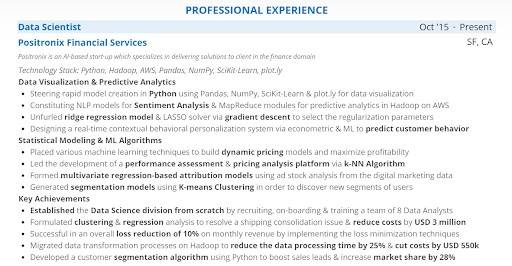With the recent development in the data science industry, the jobs in the data science space are subjected to increase by 15% from 2019 to 2029, which is much faster than average job growth.
In this sheer competitive space, it can be a mountainous task to get noticed by a recruiter for getting an interview.
The only thing that can get you closer to your dream data science job is a stellar data science resume.
Fret not! We have created an exhaustive list of tips to help you create an interview-worthy data science resume.
Create a Master Data Science Resume
If you are sending a generic resume to different recruiters for getting a job, stop that immediately.
Creating a single resume for applying for different jobs will not help you get interviews.
For that, you need to create specific resumes that cater specifically to particular jobs.
The best way to do it is by creating a master data science resume where you put down all your experiences, accomplishments in one place.
When you need to apply for a job, read the job description and pick relevant information from the master resume to create a targeted resume. This way, your chances of getting shortlisted for an interview will be much much higher.
Use Correct Formatting
Nobody want’s to read a resume that is not well presented and difficult to read. Recruiters nowadays screen through 100s of resumes every hour. They will certainly not give your resume more than 10 seconds before they move on to the next.
So, it would be best to make sure that the format you use in your resume is top-notch.
Here are some formatting tips for a data science resume:
- Use the reverse chronological resume format to write the resume unless you are changing industry or have 10+ years of specialized experience
- Write your name and contact information on the top of the resume
- Use minimal design in the resume to make it more ATS and reader-friendly
- Use professional fonts such as Ariel, Calibri, Times New Roman to write the resume
- Keep 1-inch margins on all sides of the resume
- Always save the data science resume in PDF so that the formatting does not mess up on the recruiter’s computer.
Optimize Your Professional Experience Section
The major section which correctly displays your skills and experience is the professional experience section. To make the section more impactful, you need to follow some tips:
- Instead of narrating your professional experience, create one-liner bullet points to present your skills and expertise.
- Create a cause-effect relation in the bullet points to make them more relevant
- Start each of the bullet points with a power verb such as “Conducted,”..“Managed,” “Oversaw,” “Executed,” etc.
- Quantify your achievements wherever possible to back up your statements.
- Highlight important words and numbers in the bullet points to improve readability
- Club 2-3 bullet points under relevant sub-headings. This will help the recruiter quickly scan the resume without wasting much time.
Data Scientist Resume professional experience example:

Draft a Professional Data Science Resume Summary
A resume summary is like an elevator pitch for your candidacy. So, it would help if you made sure that it perfectly showcases your skills and accomplishments and grabs the recruiter’s attention.
A perfectly written resume summary can immensely help the candidate score an interview.
To write a data science resume summary, here are some of the tips you need to follow:
- Start the resume summary with your years of experience, or certification followed by your designation
- Write the summary in paragraph format, do not use bullet points
- Finish the resume summary within 3-4 sentences.
- Do not use first or second-person pronouns in the data science resume summary
Data scientist resume summary Example:

Highlight Data Science Skills in a Dedicated Skills Section
The best way to showcase your data science core skills is by creating a dedicated section for them.
It also helps the recruiter understand your skills without having to read your entire resume.
You can create two distinct sections for technical jobs like data science, one for your core data science skills and one for your technical competencies.
Some of the key skills for a data science profile are:
- Data Analysis
- Data Presentation
- Data Visualization
- Database Management
- Data Mining
- Machine Learning
- Statistics
- Stakeholder Management
- Project Management
In the technical skills section, group different tools and methodologies into different categories. Such as,
- Programming Languages: Python, Java, C++, HTML
- Tools: Apache Spark, BigML, D3.js, MATLAB, Excel
Pro tip: Instead of adding irrelevant skills, read the job description carefully, identify the skills required for the job, and add those relevant skills in the key skills section of the data science resume.
Key Takeaways
Creating a stellar data science resume is not a difficult task. If you have the right skills and follow this resume writing guide, you can create an interview-worthy data science resume in no time.
With that, here are some of the key takeaways from the blog:
- Create specific resumes for every job and optimize those resumes with keywords found in the job descriptions
- Write the resume in reverse chronological format since it’s widely acceptable and ATS friendly
- Keep the resume design to a minimum and use professional and clean fonts to write the resume
- Create separate key skills and technical skills sections and add all your key skills in those sections
- Create one-liner bullet points to craft the professional experience section of the resume.

